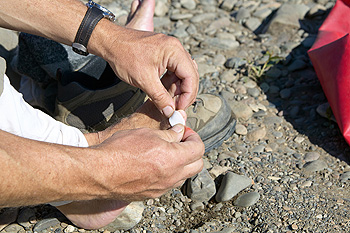
 You’re on vacation in Europe and walking is a major part of your day. You’ve worn a new pair of shoes, and after a few hours your feet are crying out in pain. When you stop to take a look, you see that you’ve developed blisters on your toes and heels. The first reaction may be to pop the blister, but this can cause an infection. If you accidently break the skin on the blister and the fluid seeps out, keep it clean and protect it with a sterile gauze bandage until the area dries up. To prevent blisters from forming, be sure to wear shoes that fit properly and are broken in before walking long distances. If the area around the blister becomes red, or if the blister is discolored or enlarges in size, it may be infected. In that case, please see a podiatrist as soon as possible for the proper treatment.
You’re on vacation in Europe and walking is a major part of your day. You’ve worn a new pair of shoes, and after a few hours your feet are crying out in pain. When you stop to take a look, you see that you’ve developed blisters on your toes and heels. The first reaction may be to pop the blister, but this can cause an infection. If you accidently break the skin on the blister and the fluid seeps out, keep it clean and protect it with a sterile gauze bandage until the area dries up. To prevent blisters from forming, be sure to wear shoes that fit properly and are broken in before walking long distances. If the area around the blister becomes red, or if the blister is discolored or enlarges in size, it may be infected. In that case, please see a podiatrist as soon as possible for the proper treatment.
Blisters are prone to making everyday activities extremely uncomfortable. If your feet are hurting, contact Massimo Pietrantoni, DPM of Rochester Podiatry, LLP. Our doctor can provide the care you need to keep you pain-free and on your feet.
Foot Blisters
Foot blisters develop as a result of constantly wearing tight or ill-fitting footwear. This happens due to the constant rubbing from the shoe, which can often lead to pain.
What Are Foot Blisters?
A foot blister is a small fluid-filled pocket that forms on the upper-most layer of the skin. Blisters are filled with clear fluid and can lead to blood drainage or pus if the area becomes infected.
How Do Blisters Form?
Blisters on the feet are often the result of constant friction of skin and material, usually by shoe rubbing. Walking in sandals, boots, or shoes that don’t fit properly for long periods of time can result in a blister. Having consistent foot moisture and humidity can easily lead to blister formation.
Prevention & Treatment
It is important to properly care for the affected area in order to prevent infection and ease the pain. Do not lance the blister and use a Band-Aid to provide pain relief. Also, be sure to keep your feet dry and wear proper fitting shoes. If you see blood or pus in a blister, seek assistance from a podiatrist.
If you have any questions, please feel free to contact one of our offices located in Brighton and Greece of Rochester, NY . We offer the newest diagnostic and treatment technologies for all your foot care needs.